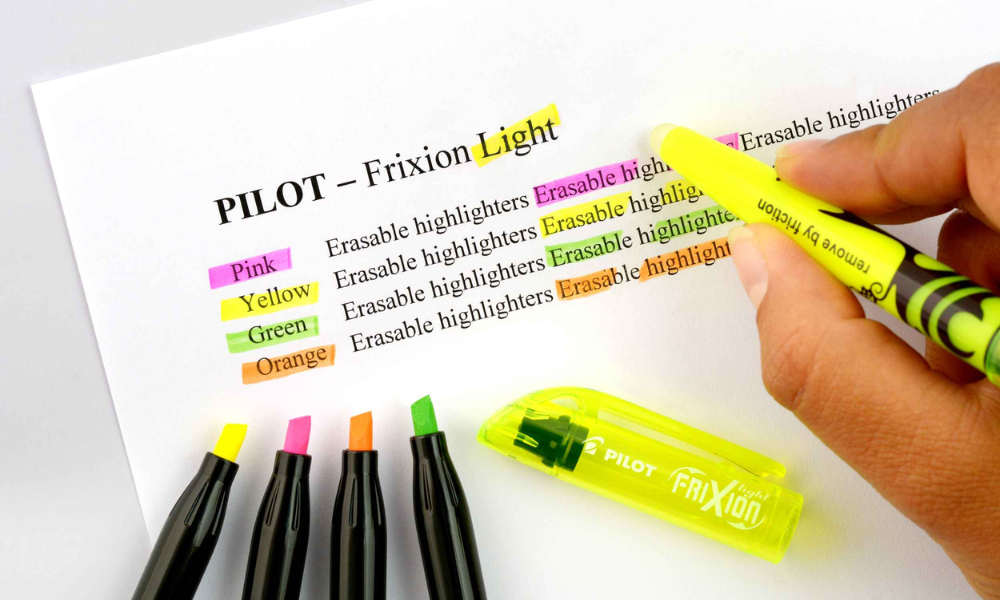They are essential tools for students aiming to improve their study habits and retain information more effectively. When used strategically, these vibrant markers can transform ordinary study sessions into highly productive ones. Here’s a comprehensive guide on how to use highlighters effectively for your study sessions.
Why Use Highlighters for Studying?

They help you visually organize information, making it easier to identify key points and remember critical details. Here are a few benefits:
-
Improved Focus: Bright colors naturally draw attention, helping you concentrate on the most important parts of the text.
-
Better Retention: Highlighting promotes active reading, which is proven to enhance memory.
-
Visual Appeal: Color-coded notes are more engaging and less monotonous, motivating you to study longer.
-
Quick Reviews: Highlighted sections enable faster revision, especially before exams.
Guide to Using Highlighters Effectively

Choose the Right Highlighter
Not all these are created equal. Selecting the right one for your needs is crucial:
-
Color Options: Pick a set with multiple colors for better organization.
-
Ink Quality: Choose smudge-free and fast-drying options to avoid messy pages.
-
Tip Size: A fine tip is ideal for underlining, while broader tips are better for highlighting entire sentences.
Read the Material First
Before you start highlighting, read the material thoroughly. Understanding the content will help you decide what’s truly important to highlight. Avoid the temptation to mark as you read for the first time, as you may end up highlighting unnecessary sections.
Highlight Key Points Only
The purpose of highlighting is to emphasize the most important information. Over-highlighting defeats the purpose and can make your notes harder to review. Follow these tips:
-
Focus on keywords, definitions, and key concepts.
-
Highlight no more than one sentence or phrase per paragraph.
-
Avoid highlighting entire paragraphs or pages.
Use a Color-Coding System
Color-coding enhances the effectiveness of highlighters by categorizing information. Here’s an example:
-
Yellow: Key points or main ideas.
-
Green: Examples or supporting details.
-
Pink: Definitions or technical terms.
-
Blue: Questions or doubts to revisit.
Customize the system based on your needs and stick to it consistently. This organization makes your notes visually structured and easier to navigate.
Combine Highlighting with Note-Taking
Highlighting works best when paired with note-taking. Write down summarized ideas, questions, or additional details in the margins or on a separate sheet. This active engagement reinforces learning and helps you process the material better.
Mistakes to Avoid While Highlighting
To maximize the benefits of its, avoid these common pitfalls:
-
Over-Highlighting: Marking too much text defeats the purpose of emphasizing key points.
-
Using Too Many Colors: A rainbow of colors can become confusing. Stick to a simple system.
-
Highlighting Without Understanding: Highlighting random sentences without comprehending their meaning is counterproductive.
-
Skipping Revisions: Highlighted sections are meant for review. Neglecting them reduces their effectiveness.
Advanced Tips for Effective Highlighting

Use Pastel Highlighters for Subtle Marking
Pastel shades are softer on the eyes, making them ideal for prolonged study sessions. They’re especially useful for dense textbooks or when you need to avoid distractions from overly bright colors.
Combine Highlighting with Mind Mapping
After highlighting the key points, create a mind map to visualize connections between ideas. This method works well for complex topics and helps reinforce understanding.
Highlight During Second Read-Throughs
On your first read, underline key phrases lightly with a pencil. On the second read, use your highlighters to mark the most critical points. This two-step process ensures you’re highlighting the right information.
Pair Highlighters with Sticky Notes
Use sticky notes for additional commentary or questions. Place them near the highlighted sections to create a more interactive study experience.
Practical Applications of Highlighters in Study Sessions
Highlighting in Textbooks
Mark the most critical sections in textbooks to create a roadmap for quick reviews. Ensure you highlight only what you’re permitted to if the book isn’t yours.
Highlighting Lecture Notes
Revise your handwritten or printed lecture notes using it. This practice helps emphasize the professor’s key points and personal annotations.
Highlighting Digital Documents
If you’re studying e-books or PDFs, use digital highlighters available in apps like Adobe Reader or Notion. Most tools offer customizable colors, enabling the same benefits as physical note markers.
Benefits of Highlighters for Different Study Styles
Visual Learners
Visual learners benefit significantly from note markers, as color-coded notes make it easier to absorb information. Combining highlighting with diagrams or charts can further enhance understanding.
Auditory Learners
For auditory learners, reading highlighted sections aloud reinforces the material. You can also use highlighted notes as prompts for recording yourself summarizing key points.
Kinesthetic Learners
Kinesthetic learners can integrate highlighting with active practices like writing summaries or creating flashcards. The physical act of highlighting itself can aid retention.
Tools to Enhance Your Highlighting Experience
Multi-Color Highlighter Sets
Invest in high-quality sets with various colors to implement an effective color-coding system.
Highlighter Pens with Erasers
Some highlighters come with erasable ink, allowing you to correct mistakes without damaging your notes.
Digital Highlighters
For those who prefer studying digitally, apps like Evernote or OneNote offer digital highlighting tools.
Final Thoughts
When used thoughtfully, it can be powerful allies in your study sessions. They help you identify, organize, and retain critical information, turning study material into a structured and engaging resource. By following these tips and avoiding common mistakes, you can harness the full potential of highlighters and elevate your academic performance.
Start experimenting with these strategies in your next study session, and see the difference highlighters can make in improving your focus, understanding, and retention

